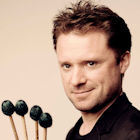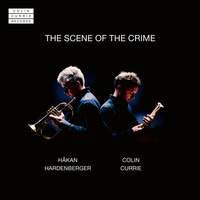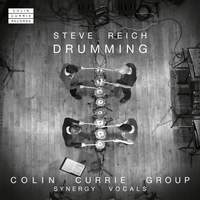Interview,
Colin Currie on The Scene of the Crime
 Scottish percussionist Colin Currie has been a passionate advocate for this often-overlooked family of instruments all his life - in 1994 he was the first percussionist to reach the finals of the BBC Young Musician of the Year competition, and since then has held a number of awards that he has used to raise the profile of percussion among classical fans.
Scottish percussionist Colin Currie has been a passionate advocate for this often-overlooked family of instruments all his life - in 1994 he was the first percussionist to reach the finals of the BBC Young Musician of the Year competition, and since then has held a number of awards that he has used to raise the profile of percussion among classical fans.
The ensemble founded by Colin that bears his name is devoted largely to promoting the works of Steve Reich, many of which make use of a wide variety of percussion instruments; indeed the first recording on Colin's own label featured Reich's Drumming.
In October he followed this with an even more adventurous concept - The Scene of the Crime, a whole album of works for trumpet and percussion, in collaboration with Håkan Hardenberger. I spoke to Colin about this intriguing musical pairing, and the possibilities it offers to composers and performers.
This is the second release on your own label, following Steve Reich’s Drumming in March this year. What was the thinking behind striking out on your own with a new label?
I craved a place where I could release the music that I deem to be important and genre-altering. There has been so much fantastic repertoire added to the percussion-themed world in recent decades and I really want to share my own branch of that musical tree. This will include a focus on Steve Reich’s music of course, concerto repertoire and diverse chamber music, often from projects initiated by myself (like the collaboration with Håkan).
Other than the obvious common thread of their instrumentation, do you think there are any other themes that link together the works on this album?
The most important thing about this album in its design, is that it is a ‘complete listen’, a ‘whole’, ideally imbibed from start to finish and heard as a suite of pieces. The works diversify a lot amongst themselves, but the play from start to finish, I believe, is a cogent and cohesive listening experience.
The most substantial work on the album, as well as the earliest, is Jolivet’s 1970s Heptade. Do you think this work opened up composers’ minds to the possibilities of this unorthodox combination of instruments, or were other people experimenting with these sonorities already?
The Jolivet is a milestone in the chamber-music-style fusion of these two instruments. It is fascinating, as it combines the single-line trumpet with an extremely wide-ranging multi-sonic percussion force, which, furthermore, sounds fresh and reinvented in each of the seven movements, a remarkable bit of creativity. Håkan absolutely raves about his trumpet writing and the profound understanding of, amongst other things, articulation on the instrument. His music is both very original and not enormously emulated, so he may have set a trend by encouraging percussion and trumpet duos to form (like in our case!) but little of the repertoire before or since sounds similar or comparable.
You refer to Duddell’s work Catch as maintaining equality between the two performers, dispensing with the idea of one being merely an accompanist. Is this true for the other works as well – or is the balance in some of them tilted in Håkan’s favour?
The roles are fluid and freely changing (and changeable) on this record. It’s chamber music first though, and the intention is two musicians playing one piece of music, from one page (we often play from the full scores in concerts). Indeed though, in the Broström and the Dean there is something of a concerto feeling for Håkan, and in both pieces I have types of orchestra at my command - Gamelan-esque in Dream Variations and full-on drum kit in ‘…the scene of the crime…’.
Broström’s Dream Variations and Börtz’s Dialogo 4 seem to sit at opposite ends of the spectrum in terms of the relationship between the two players; the Variations see the trumpet’s musings supported by a subtle percussion background, while in the Dialogo the dynamic is much more combative. Do you think the tension between these two attitudes – cooperation and competition – is always present, in any chamber music-making?
Tension/release, cooperation/competition, unity/disunity are all part of the fascinating dialectic in music. In an intense two-musician scenario, these complexities - and their outcomes - can garner augmented drama. The Börtz alone takes the listener on an increasingly disturbing voyage, from emulation of sounds between the players, through fragmentation and on into all-out hostility. Resolution is achieved, but not without a sting in the tail. Discourse is the key, but guarantees scarce.
…the scene of the crime… takes as its jumping-off point the murder of Hamlet Sr by Claudius in Shakespeare’s play, which itself has also been adapted into an opera by Brett Dean. Do you think there’s a specific programmatic element to this work, or is the relation less direct?
I would say that Dean, having plotted Hamlet in its entirety to careful and specific music and scenes, relished the opportunity for a more abstract coda to that whole process. ‘…the scene of the crime…’ is the last of several ‘Hamlet’ pieces for him, and it is a morbid, ghoulish and ghostly farewell. There’s a general atmosphere of malevolence, unease, and of something unsettling awaiting. Although some fairly catchy grooves eventually do take hold, the mood remains dark, volatile and truly cloak-and-dagger right until the rather aggressive ending.
The scene of the crime was released on Colin Currie Records on 26th October.
Available Formats: CD, MP3, FLAC, Hi-Res FLAC
'These guys have a pedigree with this unfathomably difficult score and their fresh, slick recording shows it...On top, the playing is more than secure: confident, bright and delivered on the front foot...A Drumming for this decade – and probably a few to come, too.' (Gramophone).
Available Formats: CD, MP3, FLAC, Hi-Res FLAC




